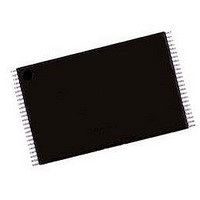AM29LV641DL120REI Spansion Inc., AM29LV641DL120REI Datasheet - Page 26

AM29LV641DL120REI
Manufacturer Part Number
AM29LV641DL120REI
Description
Flash Memory IC
Manufacturer
Spansion Inc.
Specifications of AM29LV641DL120REI
Memory Size
64Mbit
Memory Configuration
4M X 16
Ic Interface Type
Parallel
Access Time
120ns
Memory Case Style
TSOP
No. Of Pins
48
Operating Temperature Range
-40°C To +85°C
Termination Type
SMD
Available stocks
Company
Part Number
Manufacturer
Quantity
Price
The system must issue the reset command to return
the device to the read (or erase-suspend-read) mode
if DQ5 goes high during an active program or erase
operation, or if the device is in the autoselect mode.
See the next section, Reset Command, for more infor-
mation.
See also Requirements for Reading Array Data in the
Device Bus Operations section for more information.
The Read-Only Operations table provides the read pa-
rameters, and Figure 13 shows the timing diagram.
Reset Command
Writing the reset command resets the device to the
read or erase-suspend-read mode. Address bits are
don’t cares for this command.
The reset command may be written between the se-
quence cycles in an erase command sequence before
erasing begins. This resets the device to the read
mode. Once erasure begins, however, the device ig-
nores reset commands until the operation is complete.
The reset command may be written between the
sequence cycles in a program command sequence
before programming begins. This resets the device to
the read mode. If the program command sequence is
written while the device is in the Erase Suspend mode,
writing the reset command returns the device to the
erase-suspend-read mode. Once programming be-
gins, however, the device ignores reset commands
until the operation is complete.
The reset command may be written between the se-
quence cycles in an autoselect command sequence.
Once in the autoselect mode, the reset command
must be written to return to the read mode. If the de-
vice entered the autoselect mode while in the Erase
Suspend mode, writing the reset command returns the
device to the erase-suspend-read mode.
If DQ5 goes high during a program or erase operation,
writing the reset command returns the device to the
read mode (or erase-suspend-read mode if the device
was in Erase Suspend).
Autoselect Command Sequence
The autoselect command sequence allows the host
system to access the manufacturer and device codes,
and determine whether or not a sector is protected.
Table 10 shows the address and data requirements.
This method is an alternative to that shown in Table 3,
which is intended for PROM programmers and re-
quires V
mand sequence may be written to an address that is
either in the read or erase-suspend-read mode. The
autoselect command may not be written while the de-
vice is actively programming or erasing.
September 20, 2002
ID
on address pin A9. The autoselect com-
Am29LV640D/Am29LV641D
The autoselect command sequence is initiated by first
writing two unlock cycles. This is followed by a third
write cycle that contains the autoselect command. The
device then enters the autoselect mode. The system
may read at any address any number of times without
initiating another autoselect command sequence:
The system must write the reset command to return to
the read mode (or erase-suspend-read mode if the de-
vice was previously in Erase Suspend).
Enter SecSi Sector/Exit SecSi Sector
Command Sequence
The SecSi Sector region provides a secured data area
containing an 8-word random Electronic Serial Num-
ber (ESN). The system can access the SecSi Sector
region by issuing the three-cycle Enter SecSi Sector
command sequence. The device continues to access
the SecSi Sector region until the system issues the
four-cycle Exit SecSi Sector command sequence. The
Exit SecSi Sector command sequence returns the de-
vice to normal operation. Table 10 shows the address
and data requirements for both command sequences.
See also “SecSi (Secured Silicon) Sector Flash
Memory Region” for further information.
Word Program Command Sequence
Programming is a four-bus-cycle operation. The pro-
gram command sequence is initiated by writing two
unlock write cycles, followed by the program set-up
command. The program address and data are written
next, which in turn initiate the Embedded Program al-
gorithm. The system is not required to provide further
controls or timings. The device automatically provides
internally generated program pulses and verifies the
programmed cell margin. Table 10 shows the address
and data requirements for the byte program command
sequence.
When the Embedded Program algorithm is complete,
the device then returns to the read mode and ad-
dresses are no longer latched. The system can deter-
mine the status of the program operation by using
DQ7, DQ6, or RY/BY#. Refer to the Write Operation
Status section for information on these status bits.
Any commands written to the device during the Em-
bedded Program Algorithm are ignored. Note that a
A read cycle at address XX00h returns the manu-
facturer code.
A read cycle at address XX01h returns the device
code.
A read cycle to an address containing a sector
group address (SA), and the address 02h on A7–A0
returns 01h if the sector group is protected, or 00h
if it is unprotected. (Refer to Table 4 for valid sector
addresses).
25
















